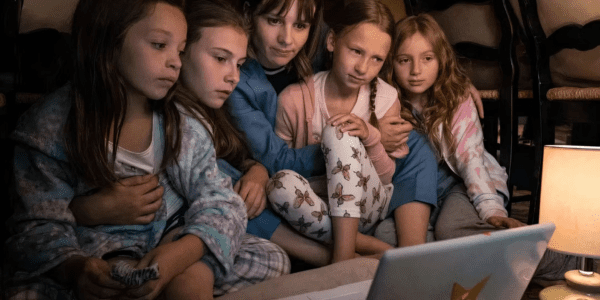When Fiction Meets Reality: How TV Shows Like “Evil” Illuminate Real Metaverse Dangers for Children
 The intersection of entertainment and real-world safety concerns has never been more relevant than in today’s digital landscape. As children increasingly immerse themselves in virtual gaming environments streaming video and metaverse platforms, popular television shows are beginning to reflect the very real dangers that lurk within these digital spaces. Paramount Plus’s supernatural drama “Evil” serves as a particularly compelling case study in how fiction can illuminate genuine threats to child safety in online gaming environments.
The intersection of entertainment and real-world safety concerns has never been more relevant than in today’s digital landscape. As children increasingly immerse themselves in virtual gaming environments streaming video and metaverse platforms, popular television shows are beginning to reflect the very real dangers that lurk within these digital spaces. Paramount Plus’s supernatural drama “Evil” serves as a particularly compelling case study in how fiction can illuminate genuine threats to child safety in online gaming environments.
Understanding the Show: Evil’s Digital Horror
Evil is an American supernatural drama that premiered on September 26, 2019, focusing on a skeptical female forensic psychologist who joins a priest-in-training and a blue-collar contractor as they investigate supposed miracles, demonic possessions, and other extraordinary occurrences. The show stars Katja Herbers, Mike Colter, and Aasif Mandvi as three individuals from vastly different backgrounds who are tasked by the Catholic Church to investigate possible supernatural incidents.
What makes “Evil” particularly relevant to discussions about online gaming safety is its unflinching examination of how technology can be weaponized against vulnerable populations—especially children—much like harmful content on social media. The show consistently explores themes of manipulation, psychological warfare, and the blurred lines between reality and digital experiences, making it a prescient commentary on modern digital dangers.
The VR Gaming Arc: A Multi-Season Warning

Season 1: Establishing the Digital Threat
The show’s exploration of gaming dangers begins in Season 1 Episode 4 “Rose390,” which opens with a horror virtual reality (VR) game sequence that may expose viewers to harmful themes. This episode features the Bouchard girls encountering VR games that range from seemingly innocent options like “Bunny Hopp” to obviously inappropriate content like “The Haunted Girl.” This early episode establishes a critical theme that would permeate the entire series: the alarming ease with which children can access inappropriate content in gaming environments, and how predators can exploit these platforms for manipulation.
The episode serves as more than entertainment—it functions as a cautionary tale about the sophisticated ways technology can be used to harm children. The show demonstrates that the very features that make VR gaming appealing to children—immersion, interactivity, and social connectivity—are the same features that make these platforms vulnerable to exploitation.
Season 4: The Culmination of Digital Manipulation
The VR gaming storyline reaches its most disturbing conclusion in the series finale of Season 4. In the final episodes, “an ominous countdown begins after the Bouchard girls start a new game on their VR goggles,” revealing the true scope of the psychological manipulation they’ve been subjected to across multiple seasons.
The show reveals that the VR goggles contain a sophisticated interface that “directly connects to the users’ brain,” allowing for unprecedented levels of psychological influence. While this fictional technology represents an extreme scenario, it serves as a chilling metaphor for how immersive gaming experiences can profoundly influence young minds, particularly when combined with social manipulation tactics employed by bad actors.
Real-World Parallels in the Story Arc
Throughout its four-season run, “Evil” uses the Bouchard family’s VR experiences to illustrate several key dangers that mirror documented real-world concerns:
Gradual Normalization: The children are slowly introduced to increasingly inappropriate content, perfectly mirroring the grooming techniques used by online predators who gradually desensitize victims to inappropriate material and behavior.
Psychological Manipulati: The games are specifically designed to influence behavior and thinking patterns, reflecting how sophisticated algorithms and design psychology can be weaponized against developing minds, mirroring the harmful tactics on social media platforms.
Parental Blindness: Perhaps most disturbingly, the mother—despite being a trained forensic psychologist—struggles to recognize the signs of digital manipulation affecting her own children, highlighting how even educated parents can miss subtle signs of online exploitation.
Technical Sophistication: The show portrays how advanced technology can be used to bypass traditional safety measures, reflecting the reality that predators often use cutting-edge tools and techniques to exploit children online.
The Reality Behind the Fiction: Current Research and Documented Dangers
The fictional scenarios portrayed in “Evil” align disturbingly well with recent research findings about real dangers in virtual environments. Recent studies show “a significant percentage of youth reported harm in these spaces, including hate speech, bullying, harassment, sexual harassment, grooming behaviors (predators building trust with minors), and unwanted exposure to violent or sexual content.”
Academic research has confirmed that “children face harassment, hate speech and exposure to adult content in the metaverse,” with experts noting that “young people are at risk of bullying or people looking to befriend, manipulate and abuse them” in virtual reality environments. Even more concerning, “virtual reality technology is moving too fast for the legal safeguards currently in place.”
The research reveals troubling patterns that echo the gradual manipulation depicted in “Evil,” highlighting how social media can expose teens to harmful influences. As with any online platform, the metaverse presents potential risks of encountering inappropriate content, unsolicited contact with strangers, and cyberbullying, with anonymity within the metaverse making it particularly difficult for parents and authorities to monitor and protect children.
Essential Resources for Parent Education
Educational Videos
Primary Resource: Kids and the Metaverse: A Parent’s Guide to Virtual Reality Safety – This comprehensive video breaks down the specific risks children face in VR environments and provides practical guidance for parents on monitoring and protecting their children.
Additional Resources:
- Search YouTube for “VR safety for children” to find current expert discussions and safety demonstrations
- Look for content from organizations like Common Sense Media and Internet Matters for ongoing safety updates related to harmful issues in online gaming and social media.
Network-Level Protection
One of the most effective ways to protect children from these dangers is through robust network-level security and parental controls that can help prevent exposure to harmful content on platforms like Netflix. FlashRouters’ parental control solutions provide comprehensive protection that extends to all connected devices in your home, including VR headsets and gaming consoles.
With a parental control device, parents can set time limits for specific tasks and activities, ensuring that their children do not spend too much time on any one thing. These systems provide an extra layer of security by preventing unwanted visitors from accessing certain parts of a network.
For gaming specifically, FlashRouters’ gaming optimization solutions can help manage network traffic that may be influenced by harmful social media trends. can help parents maintain control over their children’s gaming experiences while ensuring optimal performance for legitimate gaming activities and minimizing exposure to harmful messages.
The Five Critical Danger Categories
Based on both the fictional portrayal in “Evil” and real-world research, parents should be aware of these five primary danger categories:
1. Roblox-Like Metaverse Gaming Represented on TV/Streaming
Popular shows increasingly depict the very real dangers present in platforms like Roblox, VRChat, and other user-generated content environments, similar to the harmful issues discussed in social media narratives. These platforms allow users to create and share content with minimal oversight, creating opportunities for inappropriate material and predatory behavior.
2. Virtual Reality Horror: When Children’s Games Turn Sinister
The immersive nature of VR makes inappropriate content particularly traumatic for children. Unlike traditional gaming, VR creates a sense of physical presence that can make threatening or inappropriate content feel real and immediate.
3. The Social Engineering Pipeline: Multi-Platform Manipulation
Predators often use gaming platforms as entry points to establish relationships with children, then move the relationship to other platforms for further manipulation. This multi-platform approach makes detection and prevention particularly challenging, especially as social media can encourage risky behaviors among teens.
4. Technical Exploitation: Beyond Parental Controls
Advanced users can bypass many traditional parental controls, and VR platforms often have limited built-in safety features. The technical complexity of these systems makes it difficult for parents to fully understand the risks.
5. Psychological Impact: Long-Term Development Concerns
The combination of immersive technology and social manipulation can have lasting psychological effects on children, particularly during critical developmental periods.
 Implementing Comprehensive Protection
Implementing Comprehensive Protection
Network-Level Router and WiFi Security
Your home network is your first line of defense. Understanding your router’s capabilities is crucial for implementing effective parental controls that can help filter harmful content related to suicide and other issues. Modern routers with advanced firmware can provide granular control over which devices can access which types of content and when.
For homes with multiple gaming devices, it’s essential to monitor social media interactions that may encourage harmful behaviors. setting up a proper Wi-Fi infrastructure ensures that parental controls work effectively across all connected devices, including VR headsets, gaming consoles, and mobile devices.
Device-Specific Monitoring
While network-level controls are essential, device-specific monitoring is equally important to prevent exposure to harmful content and messages on social media. VR headsets, in particular, require special attention because they often bypass traditional web filtering and can access content through dedicated applications rather than web browsers, potentially exposing users to harmful issues.
Ongoing Education and Communication
Perhaps most importantly, the “Evil” series demonstrates that even the most sophisticated technical controls cannot replace ongoing communication and education. The show’s portrayal of a psychologist mother who misses signs of manipulation in her own children serves as a reminder that parents must maintain active, ongoing conversations about online safety.
Moving Forward: Balancing Innovation and Safety
“Children play a crucial role in driving adoption of immersive technologies—and parents, corporations, and regulators all have roles to play in balancing privacy and safety concerns to ensure they can enjoy safe, engaging, and innovative experiences.”
The goal is not to eliminate these technologies from children’s lives but to ensure they can benefit from technological innovation while remaining safe. This requires a multi-faceted approach combining technical solutions, education, and ongoing vigilance.
Conclusion: Fiction as a Warning System
“Evil” serves as more than entertainment—it functions as an early warning system about the sophisticated ways technology can be used to harm children. The show’s multi-season exploration of VR gaming dangers provides parents with a framework for understanding how predators can use gaming platforms for long-term manipulation, the importance of monitoring children’s virtual reality experiences, and the psychological impact of immersive digital content on developing minds.
The series demonstrates that protecting children in digital spaces requires the same vigilance we apply to physical safety—and perhaps even more, given the invisible and often subtle nature of online threats. By combining the insights from popular culture warnings like “Evil” with robust technical solutions and ongoing education, parents can help ensure their children benefit from technological innovation while remaining safe from its potential dangers.
As we continue to navigate this rapidly evolving digital landscape, shows like “Evil” remind us that the line between fiction and reality is increasingly thin, and that the threats portrayed on screen often have very real counterparts in the digital spaces our children inhabit daily.






